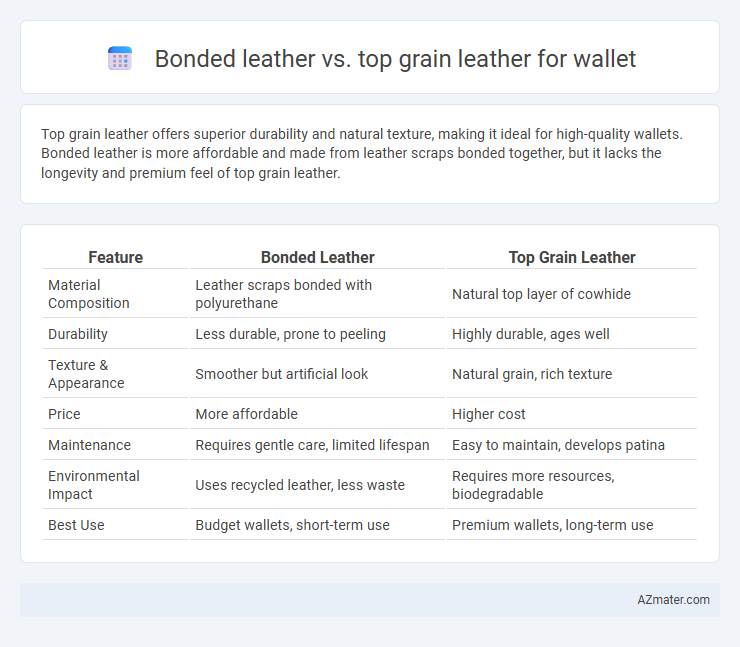Top grain leather offers superior durability and natural texture, making it ideal for high-quality wallets. Bonded leather is more affordable and made from leather scraps bonded together, but it lacks the longevity and premium feel of top grain leather.
Table of Comparison
| Feature | Bonded Leather | Top Grain Leather |
|---|---|---|
| Material Composition | Leather scraps bonded with polyurethane | Natural top layer of cowhide |
| Durability | Less durable, prone to peeling | Highly durable, ages well |
| Texture & Appearance | Smoother but artificial look | Natural grain, rich texture |
| Price | More affordable | Higher cost |
| Maintenance | Requires gentle care, limited lifespan | Easy to maintain, develops patina |
| Environmental Impact | Uses recycled leather, less waste | Requires more resources, biodegradable |
| Best Use | Budget wallets, short-term use | Premium wallets, long-term use |
Introduction to Leather Types in Wallets
Top grain leather, derived from the uppermost layer of the hide, offers durability and a smooth, attractive finish ideal for wallets, ensuring long-lasting use. Bonded leather, made by bonding leather scraps with adhesive and buffing the surface, provides a budget-friendly alternative but lacks the strength and natural texture of top grain leather. Understanding these differences helps in selecting a wallet that balances quality, appearance, and cost effectively.
What is Bonded Leather?
Bonded leather is a material made by blending shredded leather fibers with polyurethane or latex, then compressing the mixture onto a fiber backing, offering a cost-effective alternative to genuine leather. It contains up to 20% real leather content, making it less durable and prone to wear compared to top grain leather, which is made from the outer layer of the hide and is known for its strength and natural texture. For wallets, bonded leather provides an affordable aesthetic but lacks the longevity and premium feel associated with top grain leather.
What is Top Grain Leather?
Top grain leather is the second-highest quality of leather, made from the outer layer of the hide with the surface gently sanded to remove imperfections, offering durability and a smooth, consistent texture ideal for wallets. Unlike bonded leather, which is composed of leather scraps bonded with polyurethane or latex, top grain leather retains natural strength and breathability, ensuring longevity and a premium feel. Wallets crafted from top grain leather age gracefully with natural patina, making them more valuable and durable compared to bonded leather alternatives.
Durability: Bonded vs Top Grain Leather
Top grain leather offers superior durability compared to bonded leather due to its natural fiber strength and resistance to wear and tear. Bonded leather consists of leather scraps and fibers bonded together with adhesives, making it less resilient and prone to peeling or cracking over time. For wallets that require long-lasting durability and sustained aesthetic appeal, top grain leather is the preferred choice.
Appearance and Texture: Comparing Both Leathers
Top grain leather offers a smooth, supple texture with natural grain patterns that enhance the wallet's appearance, providing a luxurious and authentic feel. Bonded leather, made from shredded leather fibers bonded with polyurethane, has a more uniform and synthetic surface that lacks the depth and natural imperfections of top grain leather. The appearance of bonded leather is often glossy but less durable, while top grain leather develops a rich patina over time, improving both look and texture.
Cost Differences: Bonded vs Top Grain
Bonded leather wallets are significantly more affordable than top grain leather due to their construction from leather scraps mixed with adhesives, reducing material costs. Top grain leather, harvested from the outer layer of the hide, commands a higher price owing to its durability, premium texture, and longevity. Consumers seeking budget-friendly options often opt for bonded leather, while those prioritizing quality invest in top grain wallets despite the cost premium.
Maintenance and Care Requirements
Top grain leather wallets require regular conditioning with leather-specific oils to maintain their suppleness and prevent cracking, while bonded leather demands minimal maintenance but is prone to peeling and rapid wear. Cleaning top grain leather involves gentle wiping with a damp cloth and avoiding harsh chemicals, ensuring durability over time, whereas bonded leather can be wiped clean easily but lacks the longevity of genuine leather. Choosing top grain leather ensures better resistance to stains and environmental damage, making it a superior choice for long-term wallet care.
Eco-Friendliness & Sustainability Concerns
Top grain leather offers greater durability and longevity compared to bonded leather, which is made from leather scraps bonded with adhesive and synthetic materials, often raising concerns about chemical use and microplastic pollution. Bonded leather's lower quality leads to shorter product lifespan, contributing to increased waste, while top grain leather's natural fibers support biodegradability and a more sustainable lifecycle when sourced responsibly. Choosing wallets crafted from ethically sourced top grain leather reduces environmental impact and promotes sustainable practices in the leather industry.
Which Leather Type Suits Your Lifestyle?
Top grain leather offers superior durability and ages gracefully, making it ideal for individuals seeking a long-lasting, high-quality wallet that withstands daily use. Bonded leather, composed of leather scraps bonded with polyurethane, suits budget-conscious users who desire the look of leather without the high cost but may show wear more quickly. Selecting the right leather type depends on balancing lifestyle needs for durability, appearance, and budget.
Final Verdict: Choosing the Best Leather for Your Wallet
Top grain leather offers superior durability, a natural texture, and ages gracefully, making it the preferred choice for wallets that require longevity and a premium appearance. Bonded leather, composed of leather scraps and fibers bonded with polyurethane, provides a budget-friendly alternative but lacks the strength and authenticity of top grain leather. For wallets that combine quality, wear resistance, and a refined look, top grain leather remains the best investment.

Infographic: Bonded leather vs Top grain leather for Wallet
 azmater.com
azmater.com